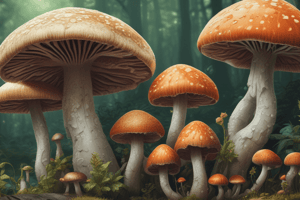Podcast
Questions and Answers
Which type of protozoan movement is characterized by extensions of the cell body?
Which type of protozoan movement is characterized by extensions of the cell body?
What do most protozoans primarily use as their nutrient source?
What do most protozoans primarily use as their nutrient source?
Which of the following best describes the classification of flatworms within helminths?
Which of the following best describes the classification of flatworms within helminths?
How do cysts contribute to the transmission of diseases like amoebic dysentery?
How do cysts contribute to the transmission of diseases like amoebic dysentery?
Signup and view all the answers
What is a defining characteristic of nematodes compared to other helminths?
What is a defining characteristic of nematodes compared to other helminths?
Signup and view all the answers
What characteristic distinguishes fungi from plants?
What characteristic distinguishes fungi from plants?
Signup and view all the answers
Which of the following best defines heterotrophic organisms?
Which of the following best defines heterotrophic organisms?
Signup and view all the answers
What is the primary ecological role of fungi?
What is the primary ecological role of fungi?
Signup and view all the answers
Which structure in fungi is primarily responsible for asexual reproduction?
Which structure in fungi is primarily responsible for asexual reproduction?
Signup and view all the answers
Which of the following statements is true regarding protozoans?
Which of the following statements is true regarding protozoans?
Signup and view all the answers
What is the role of mycorrhizae in the relationship between fungi and plants?
What is the role of mycorrhizae in the relationship between fungi and plants?
Signup and view all the answers
What component of fungal hyphae allows for flexibility and protection?
What component of fungal hyphae allows for flexibility and protection?
Signup and view all the answers
Which of the following fungi is known for producing the antibiotic penicillin?
Which of the following fungi is known for producing the antibiotic penicillin?
Signup and view all the answers
Study Notes
Fungi
- Study of Fungi: Mycology
- Fungi are heterotrophic and obtain carbon from organic sources, including plants, animals, and decaying matter.
- Few fungi are pathogenic, with the immune system providing protection.
- Important symbiotic roles include mycorrhizae, a partnership between fungi and plant roots.
- Fungi play a key role in decomposition.
- Fungi can exist as yeast, molds, and fleshy fungi.
- Cell walls are composed of chitin, a strong and flexible polysaccharide.
- Penicillin, an antibiotic, is produced by the fungus Penicillium.
- Fungal structures include hyphae, conidiophores, phialides, conidia, and septa.
Yeast
- Unicellular fungi.
Molds
- Multicellular filamentous fungi.
- Conidia are spores involved in asexual reproduction of molds.
Protozoans
- Eukaryotic and unicellular organisms.
- Lack a cell wall but have a cell membrane.
- The cell membrane acts as a pressure vessel to prevent overexpansion.
- Found in moist environments like ponds, streams, lakes, and oceans.
- Can be free-living or parasitic.
- Most are motile, using cilia, flagella, or pseudopodia.
- Nutrition: Chemoheterotrophs, obtaining nutrients from bacteria, decaying organic matter, other protozoans, and host tissue.
- Dormancy: Can enter a dormant cyst stage when conditions are unfavorable.
- Cysts can be spread through the air and potentially transmit diseases.
Helminths
- Not classified as microbes but are of interest to microbiologists due to their parasitic life cycles.
- Produce microscopic infective and diagnostic stages found in blood, feces, and urine.
- Spend significant portions of their life cycle within a mammalian host.
- Primarily flatworms and roundworms affecting humans.
- Adult helminths are visible to the naked eye, while eggs and larvae are microscopic.
Platyhelminths (Flatworms)
- Trematodes: Lung flukes, liver flukes, and blood flukes, named by their host tissue.
- Cestodes/Tapeworms: Intestinal parasites.
Nematodes (Roundworms)
- Enterobius vermicularis (Pinworm): Spends its life in the human host; eggs transmitted via fomites.
- Ascaris lumbricoides: Human parasite that does not require an intermediate host.
- Necator americanus and Ancylostoma duodenale (Hookworms): Inhabit the small intestine of humans.
Studying That Suits You
Use AI to generate personalized quizzes and flashcards to suit your learning preferences.




